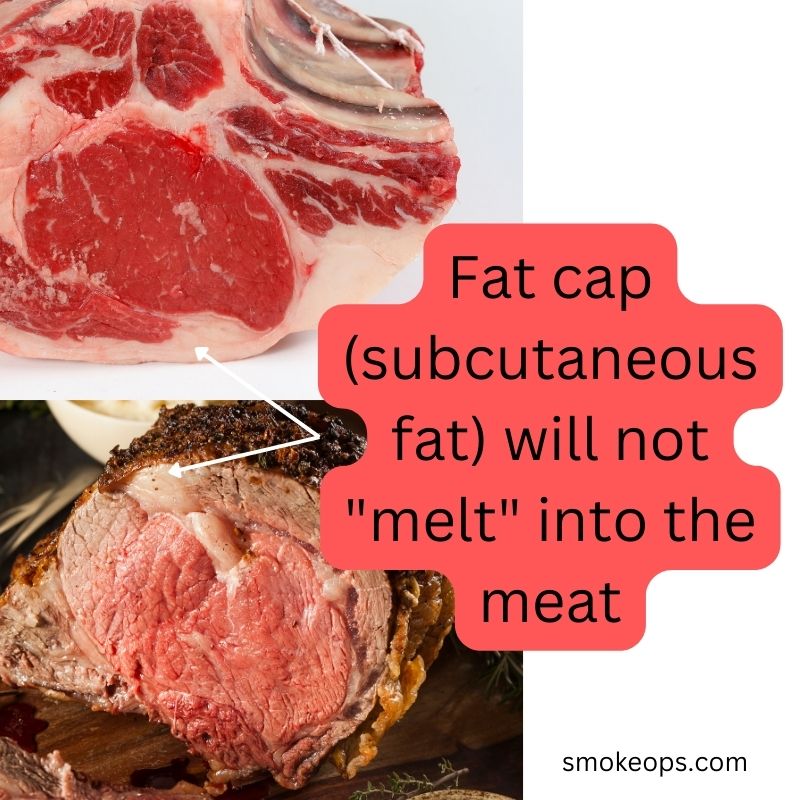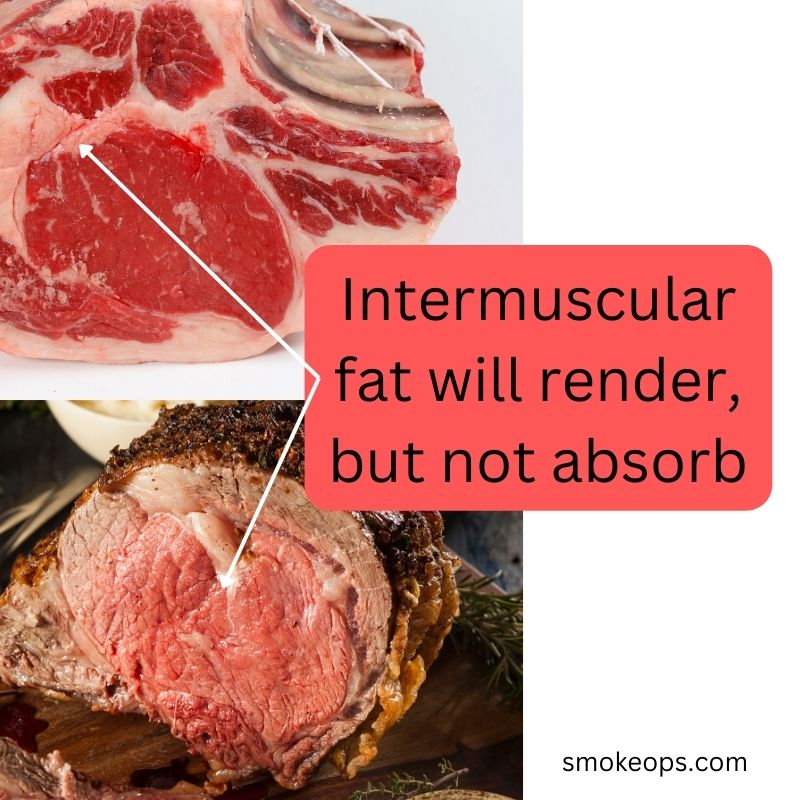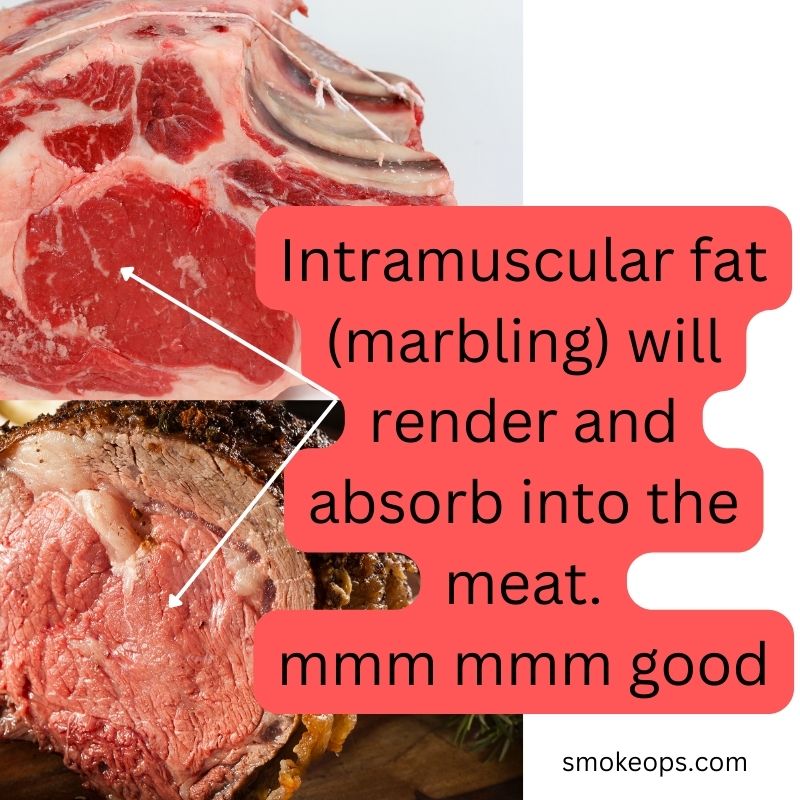If you’re a meat-smoking enthusiast or just love the taste, then you know that there’s always debate about the best way to smoke any meat, and smoking prime rib can be among the most hotly debated. Should you be smoking prime rib fat side up or down? Let’s take a closer look at both methods to see which one produces the best results.
There was a time when I fell into the “fat side up” crowd, but then I did a bunch of research and ran some tests of my own. I learned a lot from the experts and my own tests and have since changed my approach.
If you are looking for the best prime rib, read on, my friend
Fat Side Up
The case for cooking prime rib fat side up is that the fat will render as the meat cooks, basting the prime rib and keeping it moist.
Additionally, many believe that cooking prime rib like this allows the juices to flow down into the leaner portions of the meat, producing a more flavorful final product.
Proponents of fat side-up will say it prevents the formation of a crust on the underside of the prime rib (but I kinda like that crust!)
Fat Side Down
On the other side of the debate are those who believe cooking prime rib fat side down is the way to go.
The argument here is that placing the fat side down creates a barrier between the heat source and the meat, preventing it from drying out.
This makes sense to me as the idea is to cook the meat via indirect heat, which is what your smoker should be full of! If the prime rib is too close to the source of the heat (big prime rib, small smoker, etc.) then having the fat side down, closer to that source of the heat, will protect the meat.
The biggest advantage of cooking fat side down is that your rub won’t be washed away by the dissolving fat if the fat were on top. To me, this is the deciding factor.
Smoke Science time
To really understand what’s going on, we must understand the different types of fat you’ll see on your prime rib and how those fats interact with the lean muscle you’ll eventually be eating.
If you want to get the most out of cooking prime rib, it’s important to understand how all those delicious fats work together.
The fat cap is what you see sitting on top, and then there are thick slabs between lean muscles (intermuscular). But if melt-in-your-mouth results are your goal, focus on intramuscular fat – thin lines within the muscle itself.
All three have their place in creating a succulent dish, but that last one packs an extra juicy punch!
A closer look at how subcutaneous fat, or fat cap, affects the meat you are smoking

Subcutaneous fat, or the “Fat cap,” does not render and will not melt into the meat.
There is a science to consider when wondering about why that fat cap doesn’t “melt” into the meat or muscle of the prime rib.
While there’s more to it than meets the eye, why the prime rib fat cap doesn’t melt into its lean muscle is based on simple science.
In simplest terms, consider how oil and water don’t mix – we’ve all seen this.
As the meat cooks, minuscule amounts of water evaporate from the surface of the meat, preventing any fat from soaking in.
Water coming out means fat can’t go in.
It can’t swim upstream.
How intermuscular fat affects the meat you are smoking

Intermuscular fat will not fully render, but some will be absorbed into the meat, enhancing the flavor.
The thick layers of fat between the lean muscle of the prime rib will break down and render during the smoking time. However, silver linings around these little fat packs will also prevent the fatty oils from being absorbed into the meat. It happens but in smaller amounts.
This “intermuscular” fat won’t add much flavor to the meat but does contribute to its overall texture.
Personally, I love this part of the prime rib!
How does intramuscular fat, or marbling affect the meat you are smoking?

Intramuscular fat fully renders, adds great texture, and tastes wonderful!
The intermuscular fat is what is often called marbling and is the target of the long prime rib smoking time.
We want those little strands to break down and render while smoking completely. We smoke prime rib “low and slow” to give these little guys ample time to render fully. Cooking at 225 degrees(F) may be as high as 250 degrees(F) for long enough until the prime rib itself hits an internal temperature of at least 125 degrees (F) to reach a good medium rare temperature. If you want yours cooked a bit more, that’s your choice, of course.
Unless you are an expert, you should use a meat thermometer to ensure you don’t overcook. We have a couple of articles that can help, one outlines my efforts at cooking brisket without a meat thermometer (fail!), and another shows you where and how to probe meat with a meat thermometer.
This is where much of the taste and texture comes from with a well-prepared and smoked prime rib.
To better understand how fats affect the taste of your meat, spend some time with “The Role of Fat in the Palatability of Beef, Pork, and Lamb“.
So what’s the right answer?
My stance is that cooking prime rib fat side down is the way to go. Here are my not-so-humble thoughts:
- The theory that having the fat on top of the prime rib will allow the rendered and melted fat to baste and flavor the prime rib doesn’t hold up to science. That fatty oil cannot penetrate if water is evaporating (and water is evaporating!)
- Having the fat between the source of the heat and the meat, even with indirect heat, prevents the meat from drying out. Smoking prime rib is a long process so having that layer of fat acts as a heat shield and helps prevent the meat from drying out as much.
- Important point: if your heat source is above the meat, this all turns around (literally). Aaron Franklin, smoking guru, cooks with top heat and so cooks his meat, more brisket than anything, fat side up. This flies in the face of traditional wisdom, and I wonder how the dry rub on the bottom of the meat keeps it from getting washed off, but hey, it’s Aaron Franklin.
- If cooking your prime rib fat side down, the rendered fat will not wash over the prime rib during cooking, so your rubs will stay in place for the duration of the cook.
- If cooking fat side up, where do you add your rubs and spices? The spices you add will penetrate, at most, about a quarter of an inch during cooking, so adding spices or rubs to the fat cap makes no sense. So you are left with adding rubs and spices to the sides and bottom, which stand a good chance of being washed off by the melting fat during the smoking process.
- Trimming the fat to about a quarter inch and smoking it fat side down creates a delicious crust, or bark, that most prime rib lovers…love.
Smoking prime rib fat side up or down – conclusion
I hope we helped a bit with the question about smoking prime rib fat side up or down?.
My preference, and what you’ll see most other experts doing, is cooking their prime rib fat side down for the reasons stated above.
Pro tip – Don’t neglect the side dishes. Your amazing Prime Rib is the centerpiece, but don’t forget the supporting cast of characters such as baked beans, corn on the cob, etc.
Now go enjoy your tasty prime rib!
Happy smoking!
